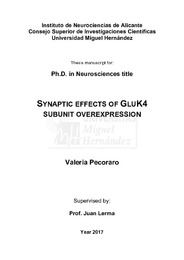Por favor, use este identificador para citar o enlazar este ítem:
https://hdl.handle.net/11000/4191Registro completo de metadatos
| Campo DC | Valor | Lengua/Idioma |
|---|---|---|
| dc.contributor.advisor | Lerma Gómez, Juan | - |
| dc.contributor.author | Pecoraro, Valeria | - |
| dc.contributor.other | Instituto de Neurociencias | es |
| dc.date.accessioned | 2017-10-30T15:46:55Z | - |
| dc.date.available | 2017-10-30T15:46:55Z | - |
| dc.date.created | 2017-06-29 | - |
| dc.date.issued | 2017-10-30 | - |
| dc.identifier.uri | http://hdl.handle.net/11000/4191 | - |
| dc.description.abstract | Kainate receptors (KARs) are members of the family of ionotropic glutamate receptors (iGluRs) which also includes NMDA and AMPA receptors. They are critically important molecules for normal brain function and constitute a complex signaling system at most of the excitatory synapses in the brain. Five separate genes (GRIK1-5) encode the different receptor subunits, GluK1-GluK5, (previously known as GluR5-7, KA1 and KA2), which assemble to form both homomeric and heteromeric receptors. The structural and functional diversity of these receptors is also achieved by alternative splicing and RNA editing of the subunits. KARs not only mediate but also modulate synaptic transmission and they use both canonical and non-canonical (metabotropic) modes of signaling. Furthermore, KARs play an instrumental role in the functional and activitydependent development of neuronal activity in many areas of the brain. Different brain pathologies involving KARs dysfunction have been also described. For instance, some abnormalities in the GRIK4 gene (coding for the GluK4 human subunit) are present in individuals with schizophrenia and learning disability. The rationale for the present study was based on recent findings indicating that common variants in the GRIK4 gene, as well as the duplication of the chromosomal region encompassing the GRIK4 locus, are associated with numerous developmental problems including bipolar disorders, schizophrenia, and autism. To investigate the role of GluK4-containing KARs in brain physiology and disease, our lab has generated mice overexpressing grik4 gene in the forebrain. These mice have an excess of GluK4 protein, which is expected to occur in humans carrying an In-Del variant of GRIK4 associated to resistance to bipolar disorders. Also, a de novo duplication of the segment containing GRIK4 in the chromosome 11 has been found is cases of autism. Indeed, behavioral studies revealed that these mice display anhedonia, enhanced anxiety, and depression, as well as impaired social interaction, which are common endophenotypes associated with Autism Spectrum Disorders (ASDs). In this work, we show that overexpression of grik4 gene in mice causes an abnormality in the neuronal activity likely affecting global information processing in the hippocampus, mainly affecting the mossy fiber-CA3 (MFs-CA3) neuron synapses, where the GluK4 protein is abundantly expressed. Indeed, the excess of GluK4 protein alters the information transfer through the hippocampal circuit. The analysis of synaptic transmission in the hippocampal MFs-CA3 synapses reveled that overexpressed GluK4 protein participates of functional KARs at both sides of the synapse. Presynaptically, GluK4-containing KA autoreceptors set a higher amount of neurotransmitter to be released, caused by their tonic activation. This leads to a marked alteration of short-term synaptic plasticity. RESUMEN Postsynaptically, an excess of GluK4 protein produces the enlargement of KARsand AMPARs-mediated currents concomitant to a depression of NMDARsmediated currents. The larger amplitude observed both in the evoked and elementary AMPARs/KARs mediated EPSC (EPSCAMPARs/KARs) is accounted for the both an increase in the KAR-mediated synaptic component and the enhanced presence of AMPARs lacking GluA2 in GluK4Over mice. These data led us to conclude that in GluK4Over mice there should be an impairment of the normal synapse maturation, where AMPARs-subunits trafficking is altered. Finally, we showed that the normalization of the levels of GluK4 protein restores the synaptic phenotype observed in GluK4Over mice. Also, the antidepressant, Tianeptine, reverts some behavioral deficits and reestablishes the synaptic normality in GluK4Over mice in slices exposed to this drug. In summary, the present results shed new light on the function of GluK4-containing KARs in establishing the properties of synaptic information flow through the trisynaptic hippocampal circuit as well as a role in the proper maturation of MFs–CA3 synapses, demonstrating the functional importance of these receptors for plasticity in the hippocampus. This work also suggests that GluK4 may be relevant for the understanding of the role played by glutamatergic neurotransmission in ASDs and for the development of potential therapeutic approaches for this neurodevelopmental/psychiatric disorder. | es |
| dc.format | application/pdf | es |
| dc.format.extent | 163 | es |
| dc.language.iso | eng | es |
| dc.rights | info:eu-repo/semantics/openAccess | es |
| dc.subject | Neurociencias | es |
| dc.subject.other | CDU::6 - Ciencias aplicadas::61 - Medicina::616 - Patología. Medicina clínica. Oncología::616.8 - Neurología. Neuropatología. Sistema nervioso | es |
| dc.title | Synaptic effects of GluK4 subunit overexpression | es |
| dc.type | info:eu-repo/semantics/doctoralThesis | es |

Ver/Abrir:
TD Pecoraro, Valeria.pdf
6,16 MB
Adobe PDF
Compartir:
 La licencia se describe como: Atribución-NonComercial-NoDerivada 4.0 Internacional.
La licencia se describe como: Atribución-NonComercial-NoDerivada 4.0 Internacional.
.png)